Local Adaptive Image Filtering Based on Recursive Dilation Segmentation
Abstract
1. Introduction
2. Motivation
3. Proposed Method
3.1. Recursive Dilation Segmentation Module
| Algorithm 1: Proposed LAIF |
 |
3.2. Local Adaptive Image Smoothing Module
4. Experiments
4.1. Parameter Study
4.2. Dehazing
4.3. Denoising
4.4. Detail Enhancement
4.5. Edge Preserving
5. Conclusions
Author Contributions
Funding
Institutional Review Board Statement
Informed Consent Statement
Data Availability Statement
Conflicts of Interest
References
- Ma, R.; Hu, H.; Xing, S.; Li, Z. Efficient and Fast Real-World Noisy Image Denoising by Combining Pyramid Neural Network and Two-Pathway Unscented Kalman Filter. IEEE Trans. Image Process. 2020, 29, 3927–3940. [Google Scholar] [CrossRef] [PubMed]
- Cao, Y.; Yang, M.Y.; Tisse, C.L. Effective Strip Noise Removal for Low-Textured Infrared Images Based on 1-D Guided Filtering. IEEE Trans. Circuits Syst. Video Technol. 2016, 26, 2176–2188. [Google Scholar] [CrossRef]
- Quan, Y.; Chen, M.; Pang, T.; Ji, H. Self2Self with Dropout: Learning Self-Supervised Denoising From Single Image. In Proceedings of the 2020 IEEE/CVF Conference on Computer Vision and Pattern Recognition (CVPR), Seattle, WA, USA, 13–19 June 2020; pp. 1887–1895. [Google Scholar] [CrossRef]
- Li, S.; Kang, X.; Hu, J. Image Fusion with Guided Filtering. IEEE Trans. Image Process. 2013, 22, 2864–2875. [Google Scholar] [CrossRef] [PubMed]
- Li, Z.; Zheng, J. Single Image De-Hazing Using Globally Guided Image Filtering. IEEE Trans. Image Process. 2018, 27, 442–450. [Google Scholar] [CrossRef]
- Liu, J.; Wang, S.; Wang, X.; Ju, M.; Zhang, D. A Review of Remote Sensing Image Dehazing. Sensors 2021, 21, 3926. [Google Scholar] [CrossRef]
- He, Z.; Gong, C.; Hu, Y.; Li, L. Remote Sensing Image Dehazing Based on an Attention Convolutional Neural Network. IEEE Access 2022, 10, 68731–68739. [Google Scholar] [CrossRef]
- Jiang, B.; Chen, G.; Wang, J.; Ma, H.; Wang, L.; Wang, Y.; Chen, X. Deep Dehazing Network for Remote Sensing Image with Non-Uniform Haze. Remote Sens. 2021, 13, 4443. [Google Scholar] [CrossRef]
- Kaplan, N.H.; Erer, I.; Kumlu, D. Image Enhancement Methods for Remote Sensing: A Survey. In Recent Remote Sensing Sensor Applications; Marghany, M., Ed.; IntechOpen: Rijeka, Croatia, 2021; Chapter 5. [Google Scholar] [CrossRef]
- Tomasi, C.; Manduchi, R. Bilateral filtering for gray and color images. In Proceedings of the Sixth International Conference on Computer Vision (IEEE Cat. No.98CH36271), Bombay, India, 7 January 1998; pp. 839–846. [Google Scholar] [CrossRef]
- Petschnigg, G.; Szeliski, R.; Agrawala, M.; Cohen, M.; Hoppe, H.; Toyama, K. Digital photography with flash and no-flash image pairs. ACM Trans. Graph. (TOG) 2004, 23, 664–672. [Google Scholar] [CrossRef]
- Mozerov, M.G.; van de Weijer, J. Global Color Sparseness and a Local Statistics Prior for Fast Bilateral Filtering. IEEE Trans. Image Process. 2015, 24, 5842–5853. [Google Scholar] [CrossRef]
- Adams, A.; Gelfand, N.; Dolson, J.; Levoy, M. Gaussian KD-Trees for Fast High-Dimensional Filtering. In Proceedings of the ACM SIGGRAPH 2009 Papers, Association for Computing Machinery, SIGGRAPH ’09, New York, NY, USA, 3–7 August 2009. [Google Scholar] [CrossRef]
- Gavaskar, R.G.; Chaudhury, K.N. Fast Adaptive Bilateral Filtering. IEEE Trans. Image Process. 2019, 28, 779–790. [Google Scholar] [CrossRef]
- He, K.; Sun, J.; Tang, X. Guided Image Filtering. IEEE Trans. Pattern Anal. Mach. Intell. 2013, 35, 1397–1409. [Google Scholar] [CrossRef]
- Ham, B.; Cho, M.; Ponce, J. Robust Guided Image Filtering Using Nonconvex Potentials. IEEE Trans. Pattern Anal. Mach. Intell. 2018, 40, 192–207. [Google Scholar] [CrossRef]
- Sun, Z.; Han, B.; Li, J.; Zhang, J.; Gao, X. Weighted Guided Image Filtering With Steering Kernel. IEEE Trans. Image Process. 2020, 29, 500–508. [Google Scholar] [CrossRef]
- Shi, Z.; Chen, Y.; Gavves, E.; Mettes, P.; Snoek, C.G.M. Unsharp Mask Guided Filtering. IEEE Trans. Image Process. 2021, 30, 7472–7485. [Google Scholar] [CrossRef]
- Kopf, J.; Cohen, M.F.; Lischinski, D.; Uyttendaele, M. Joint Bilateral Upsampling. ACM Trans. Graph. 2007, 26, 96. [Google Scholar] [CrossRef]
- Liu, W.; Zhang, P.; Chen, X.; Shen, C.; Huang, X.; Yang, J. Embedding Bilateral Filter in Least Squares for Efficient Edge-Preserving Image Smoothing. IEEE Trans. Circuits Syst. Video Technol. 2020, 30, 23–35. [Google Scholar] [CrossRef]
- Guo, X.; Li, Y.; Ma, J.; Ling, H. Mutually Guided Image Filtering. IEEE Trans. Pattern Anal. Mach. Intell. 2020, 42, 694–707. [Google Scholar] [CrossRef]
- Li, Z.; Zheng, J.; Zhu, Z.; Yao, W.; Wu, S. Weighted Guided Image Filtering. IEEE Trans. Image Process. 2015, 24, 120–129. [Google Scholar] [CrossRef]
- Deng, X.; Hasan, M.; Carr, N.; Xu, Z.; Marschner, S. Path graphs: Iterative path space filtering. ACM Trans. Graph. 2021, 40, 276:1–276:15. [Google Scholar] [CrossRef]
- Ochotorena, C.N.; Yamashita, Y. Anisotropic Guided Filtering. IEEE Trans. Image Process. 2020, 29, 1397–1412. [Google Scholar] [CrossRef]
- Ju, M.; Ding, C.; Ren, W.; Yang, Y.; Zhang, D.; Guo, Y.J. IDE: Image Dehazing and Exposure Using an Enhanced Atmospheric Scattering Model. IEEE Trans. Image Process. 2021, 30, 2180–2192. [Google Scholar] [CrossRef]
- Belyaev, A.; Fayolle, P.A. Adaptive Curvature-Guided Image Filtering for Structure + Texture Image Decomposition. IEEE Trans. Image Process. 2018, 27, 5192–5203. [Google Scholar] [CrossRef] [PubMed]
- Ju, M.; Ding, C.; Guo, C.A.; Ren, W.; Tao, D. IDRLP: Image Dehazing Using Region Line Prior. IEEE Trans. Image Process. 2021, 30, 9043–9057. [Google Scholar] [CrossRef]
- Wu, L.; Jong, C.C. A High-Throughput VLSI Architecture for Real-Time Full-HD Gradient Guided Image Filter. IEEE Trans. Circuits Syst. Video Technol. 2019, 29, 1868–1877. [Google Scholar] [CrossRef]
- Farbman, Z.; Fattal, R.; Lischinski, D.; Szeliski, R. Edge-preserving decompositions for multi-scale tone and detail manipulation. ACM Trans. Graph. (TOG) 2008, 27, 1–10. [Google Scholar] [CrossRef]
- Min, D.; Choi, S.; Lu, J.; Ham, B.; Sohn, K.; Do, M.N. Fast Global Image Smoothing Based on Weighted Least Squares. IEEE Trans. Image Process. 2014, 23, 5638–5653. [Google Scholar] [CrossRef] [PubMed]
- Yin, H.; Gong, Y.; Qiu, G. Side Window Filtering. In Proceedings of the 2019 IEEE/CVF Conference on Computer Vision and Pattern Recognition (CVPR), Long Beach, CA, USA, 16–17 June 2019; pp. 8750–8758. [Google Scholar] [CrossRef]
- Berger, T.; Stromberg, J.; Eltoft, T. Adaptive regularized constrained least squares image restoration. IEEE Trans. Image Process. 1999, 8, 1191–1203. [Google Scholar] [CrossRef]
- Hirakawa, K.; Parks, T. Image denoising using total least squares. IEEE Trans. Image Process. 2006, 15, 2730–2742. [Google Scholar] [CrossRef]
- Mesarovic, V.; Galatsanos, N.; Katsaggelos, A. Regularized constrained total least squares image restoration. IEEE Trans. Image Process. 1995, 4, 1096–1108. [Google Scholar] [CrossRef]
- Gendreau, T. Process management issues in message-based multiprocessors. In Proceedings of the Conference Proceedings ’88, IEEE Southeastcon, Knoxville, TN, USA, 10–13 April 1988; pp. 103–107. [Google Scholar] [CrossRef]
- Zhou, Z.; Wang, B.; Ma, J. Scale-Aware Edge-Preserving Image Filtering via Iterative Global Optimization. IEEE Trans. Multimed. 2018, 20, 1392–1405. [Google Scholar] [CrossRef]
- Caraffa, L.; Tarel, J.P.; Charbonnier, P. The Guided Bilateral Filter: When the Joint/Cross Bilateral Filter Becomes Robust. IEEE Trans. Image Process. 2015, 24, 1199–1208. [Google Scholar] [CrossRef]
- Gamboa, L.E.; Guertin, J.; Nowrouzezahrai, D. Scalable appearance filtering for complex lighting effects. ACM Trans. Graph. 2018, 37, 277:1–277:13. [Google Scholar] [CrossRef]
- Sugimoto, K.; Kamata, S.I. Compressive Bilateral Filtering. IEEE Trans. Image Process. 2015, 24, 3357–3369. [Google Scholar] [CrossRef]
- Papari, G.; Idowu, N.; Varslot, T. Fast Bilateral Filtering for Denoising Large 3D Images. IEEE Trans. Image Process. 2017, 26, 251–261. [Google Scholar] [CrossRef]
- He, S.; Yang, Q.; Lau, R.W.H.; Yang, M.H. Fast Weighted Histograms for Bilateral Filtering and Nearest Neighbor Searching. IEEE Trans. Circuits Syst. Video Technol. 2016, 26, 891–902. [Google Scholar] [CrossRef]
- Ong, F.; Milanfar, P.; Getreuer, P. Local Kernels That Approximate Bayesian Regularization and Proximal Operators. IEEE Trans. Image Process. 2019, 28, 3007–3019. [Google Scholar] [CrossRef]
- Nehab, D.F.; Maximo, A. Parallel recursive filtering of infinite input extensions. ACM Trans. Graph. 2016, 35, 204:1–204:13. [Google Scholar] [CrossRef]
- Hung, K.W.; Siu, W.C. Robust Soft-Decision Interpolation Using Weighted Least Squares. IEEE Trans. Image Process. 2012, 21, 1061–1069. [Google Scholar] [CrossRef]
- Xu, R.; Xu, Y.; Quan, Y. Structure-Texture Image Decomposition Using Discriminative Patch Recurrence. IEEE Trans. Image Process. 2021, 30, 1542–1555. [Google Scholar] [CrossRef]
- Li, Y.; Huang, J.B.; Ahuja, N.; Yang, M.H. Joint Image Filtering with Deep Convolutional Networks. IEEE Trans. Pattern Anal. Mach. Intell. 2019, 41, 1909–1923. [Google Scholar] [CrossRef]
- Han, R.; Feng, W.; Wang, S. Fast Learning of Spatially Regularized and Content Aware Correlation Filter for Visual Tracking. IEEE Trans. Image Process. 2020, 29, 7128–7140. [Google Scholar] [CrossRef]
- Chen, S.; Duan, C.; Yang, Y.; Li, D.; Feng, C.; Tian, D. Deep Unsupervised Learning of 3D Point Clouds via Graph Topology Inference and Filtering. IEEE Trans. Image Process. 2020, 29, 3183–3198. [Google Scholar] [CrossRef]
- Tian, L.; Tu, Z.; Zhang, D.; Liu, J.; Li, B.; Yuan, J. Unsupervised Learning of Optical Flow With CNN-Based Non-Local Filtering. IEEE Trans. Image Process. 2020, 29, 8429–8442. [Google Scholar] [CrossRef] [PubMed]
- Li, T.; Xu, M.; Zhu, C.; Yang, R.; Wang, Z.; Guan, Z. A Deep Learning Approach for Multi-Frame In-Loop Filter of HEVC. IEEE Trans. Image Process. 2019, 28, 5663–5678. [Google Scholar] [CrossRef] [PubMed]
- Chen, J.; Adams, A.; Wadhwa, N.; Hasinoff, S.W. Bilateral guided upsampling. ACM Trans. Graph. 2016, 35, 203:1–203:8. [Google Scholar] [CrossRef]
- Huang, Z.; Sun, J.; Guo, X.; Shang, M. Adaptive Deep Reinforcement Learning-Based In-Loop Filter for VVC. IEEE Trans. Image Process. 2021, 30, 5439–5451. [Google Scholar] [CrossRef]
- Bianchi, F.M.; Grattarola, D.; Livi, L.; Alippi, C. Graph Neural Networks with Convolutional ARMA Filters. IEEE Trans. Pattern Anal. Mach. Intell. 2021, 44, 3496–3507. [Google Scholar] [CrossRef] [PubMed]
- Wang, D.; Xia, S.; Yang, W.; Liu, J. Combining Progressive Rethinking and Collaborative Learning: A Deep Framework for In-Loop Filtering. IEEE Trans. Image Process. 2021, 30, 4198–4211. [Google Scholar] [CrossRef]
- Liu, J.; Guo, G. Vehicle Localization During GPS Outages With Extended Kalman Filter and Deep Learning. IEEE Trans. Instrum. Meas. 2021, 70, 1–10. [Google Scholar] [CrossRef]
- Adams, A. Fast median filters using separable sorting networks. ACM Trans. Graph. 2021, 40, 70:1–70:11. [Google Scholar] [CrossRef]
- Feng, L.; Cai, Y.; Wei, E.; Li, J. Graph neural networks with global noise filtering for session-based recommendation. Neurocomputing 2022, 472, 113–123. [Google Scholar] [CrossRef]
- Zhang, W.; Jiao, L.; Li, Y.; Liu, J. Sparse Learning-Based Correlation Filter for Robust Tracking. IEEE Trans. Image Process. 2021, 30, 878–891. [Google Scholar] [CrossRef]
- Chen, C.; Luo, J.; Parker, K. Image segmentation via adaptive K-mean clustering and knowledge-based morphological operations with biomedical applications. IEEE Trans. Image Process. 1998, 7, 1673–1683. [Google Scholar] [CrossRef] [PubMed]
- Rezaee, M.; van der Zwet, P.; Lelieveldt, B.; van der Geest, R.; Reiber, J. A multiresolution image segmentation technique based on pyramidal segmentation and fuzzy clustering. IEEE Trans. Image Process. 2000, 9, 1238–1248. [Google Scholar] [CrossRef] [PubMed]
- He, K.; Sun, J.; Tang, X. Single Image Haze Removal Using Dark Channel Prior. IEEE Trans. Pattern Anal. Mach. Intell. 2011, 33, 2341–2353. [Google Scholar] [CrossRef]
- Ancuti, C.O.; Ancuti, C.; Timofte, R.; Vleeschouwer, C.D. I-HAZE: A dehazing benchmark with real hazy and haze-free indoor images. arXiv 2018, arXiv:1804.05091v1. [Google Scholar]
- Ancuti, C.O.; Ancuti, C.; Timofte, R.; Vleeschouwer, C.D. O-HAZE: A dehazing benchmark with real hazy and haze-free outdoor images. In Proceedings of the IEEE Conference on Computer Vision and Pattern Recognition, NTIRE Workshop, 2018, NTIRE CVPR’18, Salt Lake City, UT, USA, 18–22 June 2018. [Google Scholar]
- Aksoy, Y.; Kim, C.; Kellnhofer, P.; Paris, S.; Elgharib, M.; Pollefeys, M.; Matusik, W. A Dataset of Flash and Ambient Illumination Pairs from the Crowd. In Proceedings of the 15th European Conference on Computer Vision, Munich, Germany, 8–14 September 2018. [Google Scholar]
- Yang, P.; Lu, W.; Liu, K.; Zhang, G. Image enhancement using smoothing with a Gaussian filter. Pattern Recognit. Lett. 2010, 31, 406–412. [Google Scholar]
- Rudin, L.I.; Osher, S.; Fatemi, E. Nonlinear total variation based noise removal algorithms. Phys. Nonlinear Phenom. 1992, 60, 259–268. [Google Scholar] [CrossRef]
- Sheikh, H.R.; Sabir, M.F.; Bovik, A.C. A Statistical Evaluation of Recent Full Reference Image Quality Assessment Algorithms. IEEE Trans. Image Process. 2006, 15, 3440–3451. [Google Scholar] [CrossRef]
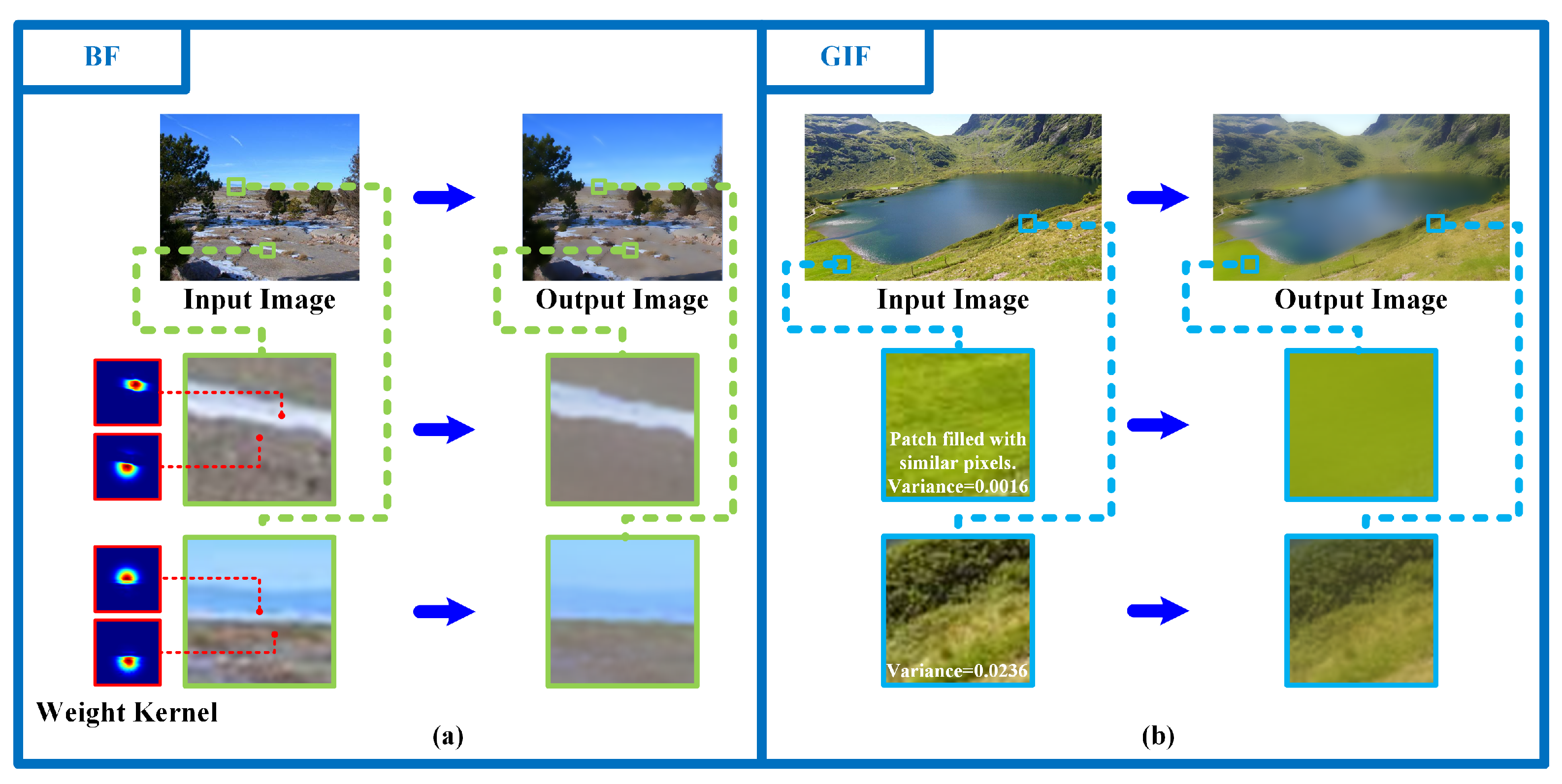


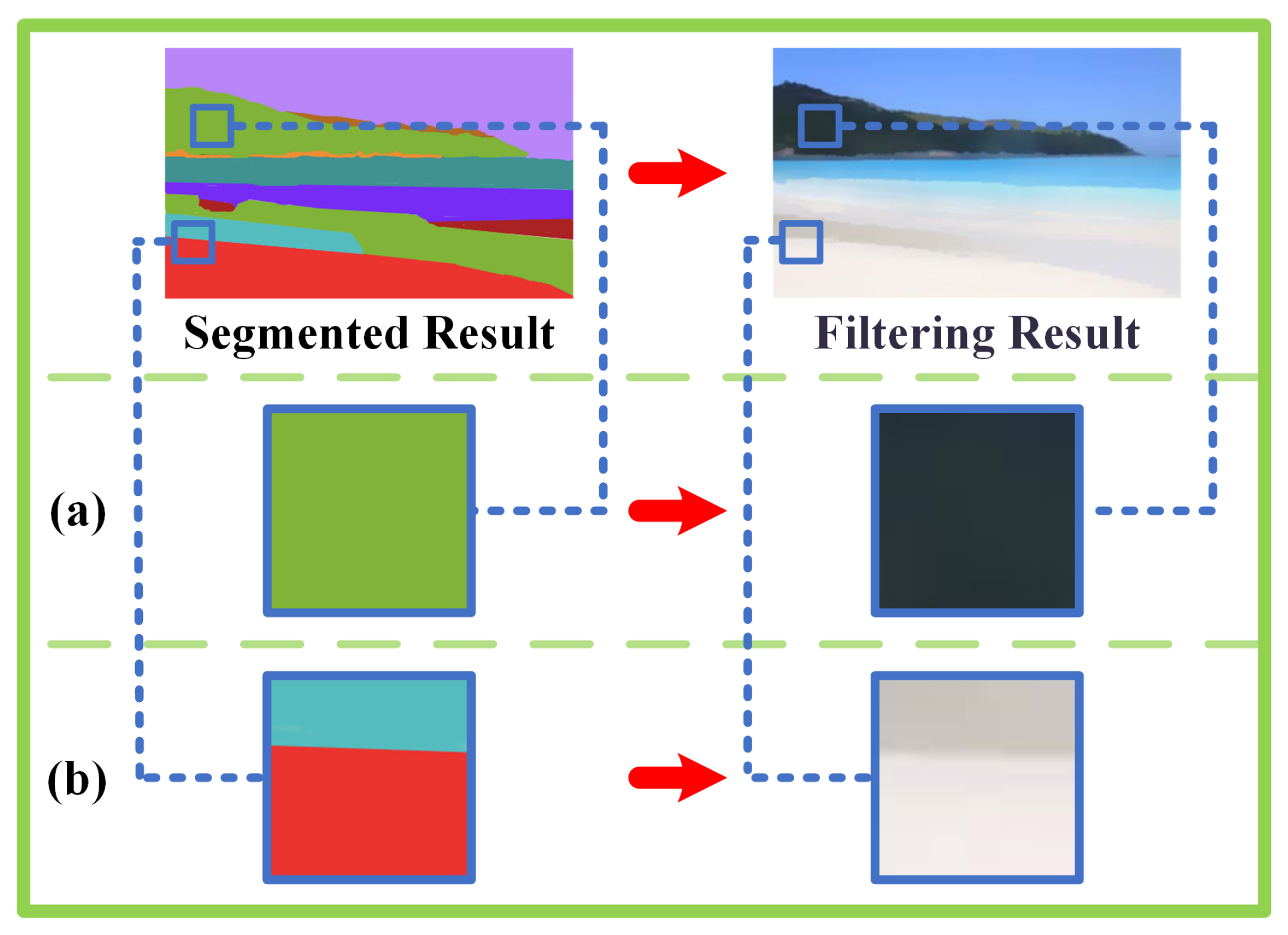

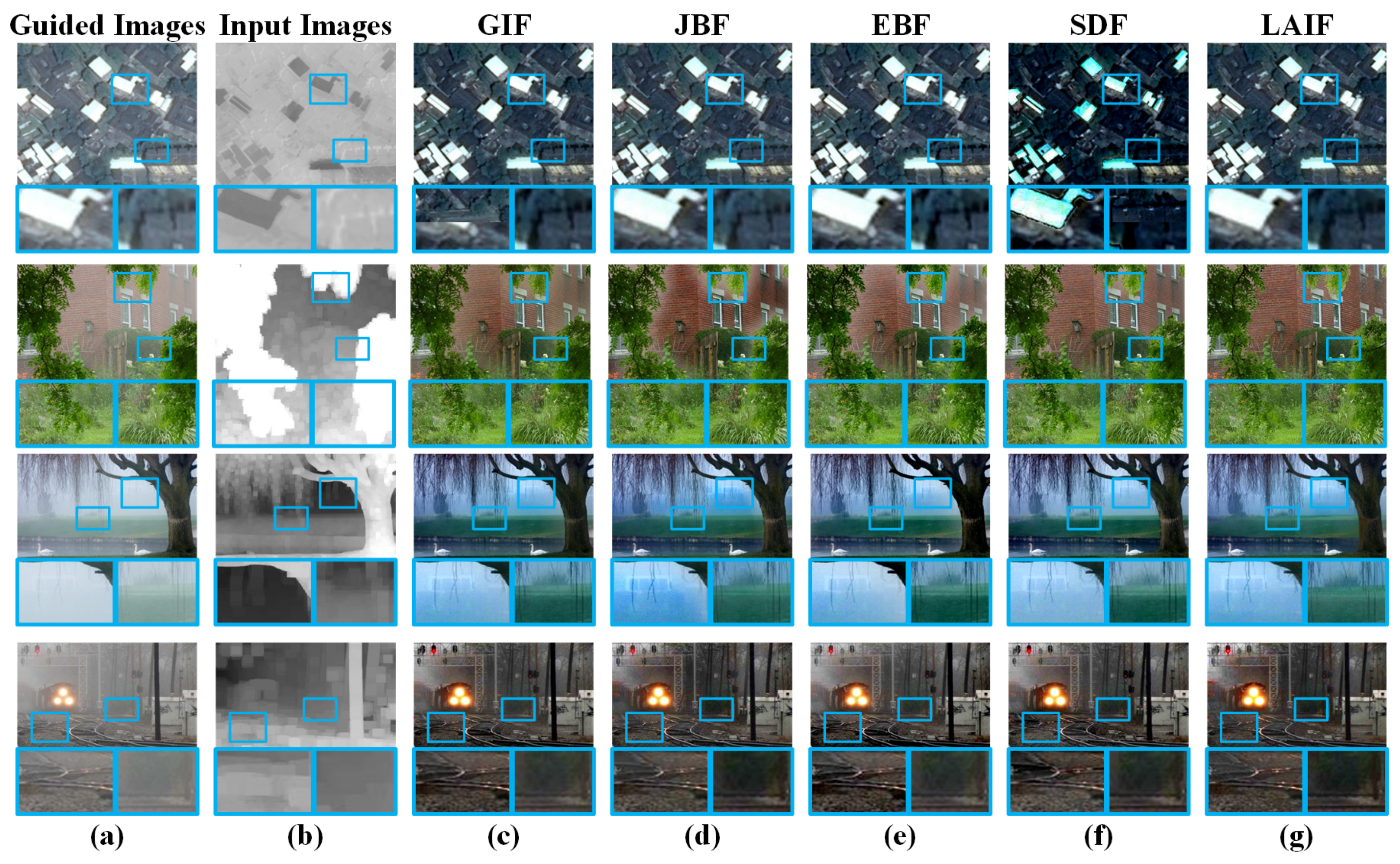

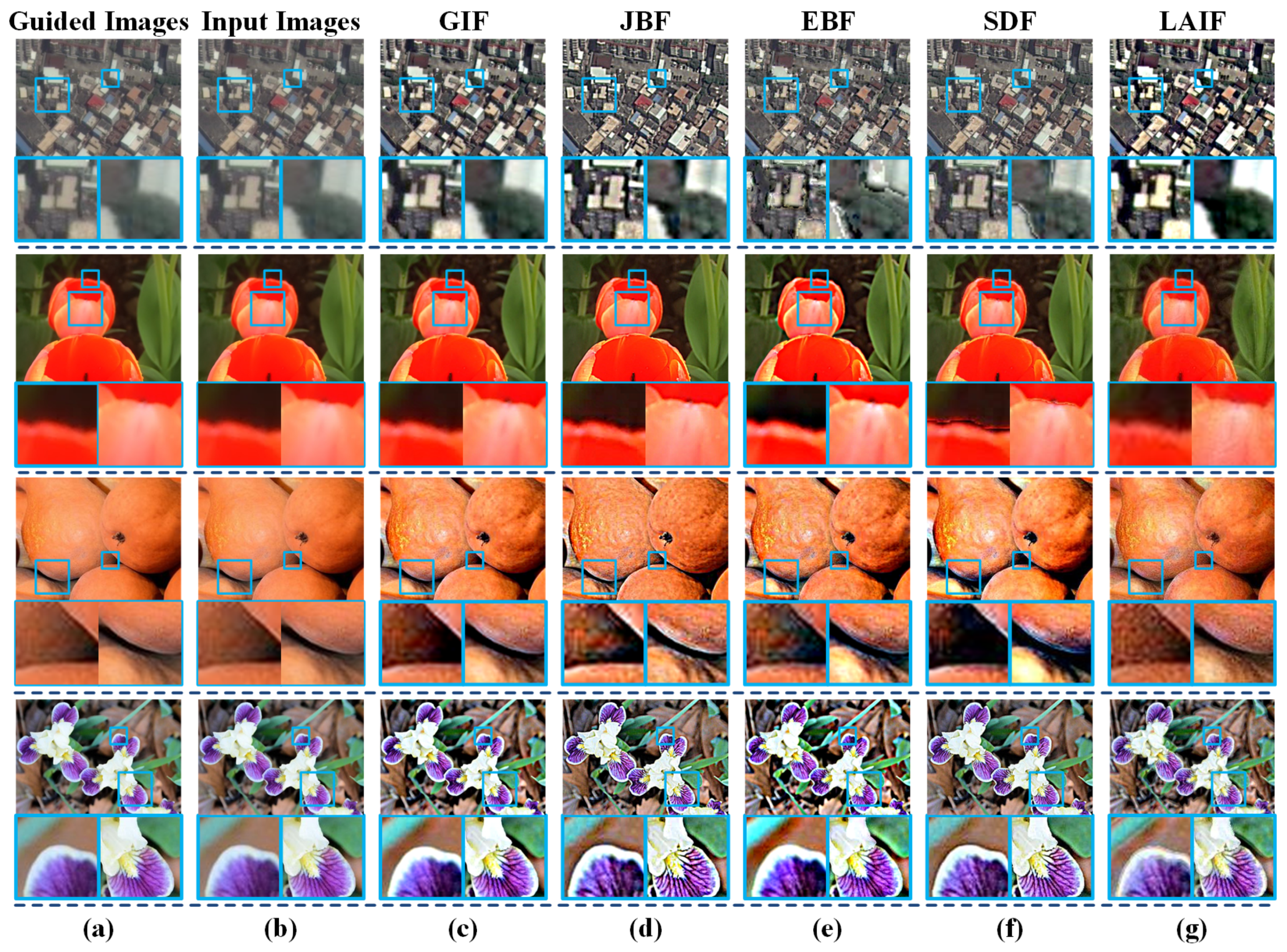
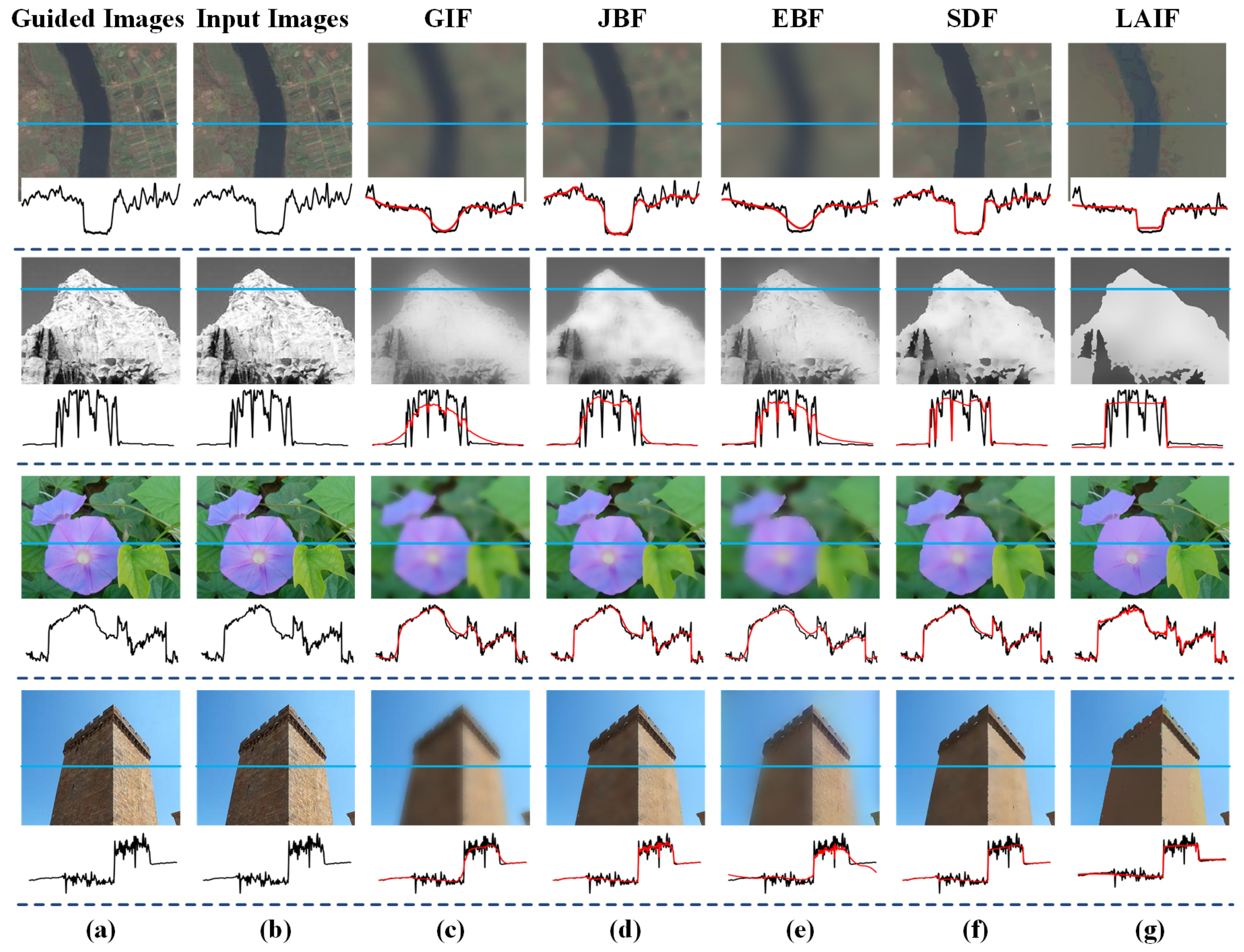
| Dataset | Metric | Methods | ||||
|---|---|---|---|---|---|---|
| EBF | GIF | GBF | SDF | Ours | ||
| I-HAZE | SSIM | 0.7297 | 0.7205 | 0.7248 | 0.6217 | 0.7274 |
| PSNR | 28.0868 | 28.0389 | 28.0834 | 27.8027 | 28.1024 | |
| O-HAZE | SSIM | 0.7002 | 0.6891 | 0.6887 | 0.6117 | 0.7124 |
| PSNR | 28.1271 | 28.1691 | 28.2235 | 27.8548 | 28.2481 | |
| Metric | w/o Denoising | Flash/No-Flash Denoising | Standard Denoising | |||||||
|---|---|---|---|---|---|---|---|---|---|---|
| EBF | GIF | GBF | SDF | Ours | GF | MF | TV | Ours | ||
| SSIM | 0.4022 | 0.7241 | 0.7105 | 0.7346 | 0.7312 | 0.7588 | 0.6978 | 0.6325 | 0.5568 | 0.7018 |
| PSNR | 28.0484 | 27.7332 | 28.2232 | 27.4847 | 27.5689 | 28.5654 | 27.6523 | 28.0335 | 27.8402 | 27.9041 |
| Dataset | Metric | Methods | ||||
|---|---|---|---|---|---|---|
| EBF | GIF | GBF | SDF | Ours | ||
| gblur | SSIM | 0.7654 | 0.7609 | 0.6724 | 0.7394 | 0.7945 |
| PSNR | 33.7678 | 29.1134 | 29.3686 | 30.0151 | 31.1163 | |
| jp2k | SSIM | 0.6912 | 0.7048 | 0.5796 | 0.6283 | 0.7267 |
| PSNR | 29.4225 | 28.9668 | 29.0575 | 29.4278 | 29.541 | |
| jpeg | SSIM | 0.6534 | 0.6718 | 0.5238 | 0.5694 | 0.6912 |
| PSNR | 28.9976 | 28.7603 | 28.7542 | 29.0288 | 28.8364 | |
Disclaimer/Publisher’s Note: The statements, opinions and data contained in all publications are solely those of the individual author(s) and contributor(s) and not of MDPI and/or the editor(s). MDPI and/or the editor(s) disclaim responsibility for any injury to people or property resulting from any ideas, methods, instructions or products referred to in the content. |
© 2023 by the authors. Licensee MDPI, Basel, Switzerland. This article is an open access article distributed under the terms and conditions of the Creative Commons Attribution (CC BY) license (https://creativecommons.org/licenses/by/4.0/).
Share and Cite
Zhang, J.; Chen, C.; Chen, K.; Ju, M.; Zhang, D. Local Adaptive Image Filtering Based on Recursive Dilation Segmentation. Sensors 2023, 23, 5776. https://doi.org/10.3390/s23135776
Zhang J, Chen C, Chen K, Ju M, Zhang D. Local Adaptive Image Filtering Based on Recursive Dilation Segmentation. Sensors. 2023; 23(13):5776. https://doi.org/10.3390/s23135776
Chicago/Turabian StyleZhang, Jialiang, Chuheng Chen, Kai Chen, Mingye Ju, and Dengyin Zhang. 2023. "Local Adaptive Image Filtering Based on Recursive Dilation Segmentation" Sensors 23, no. 13: 5776. https://doi.org/10.3390/s23135776
APA StyleZhang, J., Chen, C., Chen, K., Ju, M., & Zhang, D. (2023). Local Adaptive Image Filtering Based on Recursive Dilation Segmentation. Sensors, 23(13), 5776. https://doi.org/10.3390/s23135776






